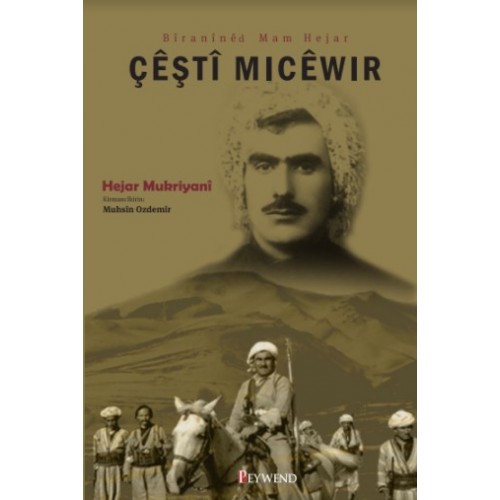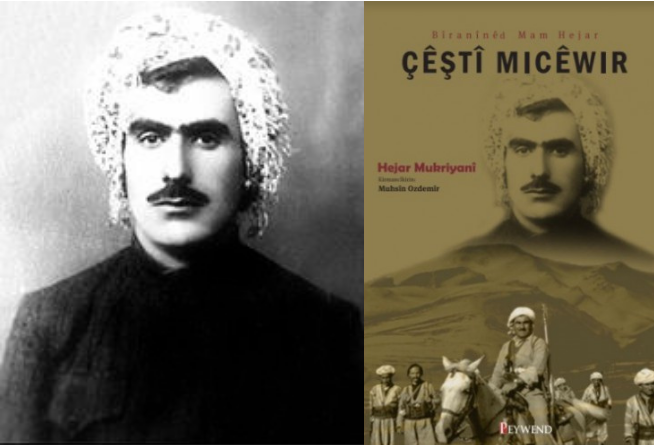Walat Ramin Azad
Hazhar's autobiography entitled Cheshti Mijewr (2022) was translated into Kurmanji by "Mohsen Ozdemir" and was published by "Paywand" publishing press.
Before I read this book, I thought Hazhar was only a poet but he was undoubtedly a poet, author, translator, activist, encyclopedia writer, Peshmerga, and Mullah Mustafa Barzani's friend.
Although Hazhar began to write his autobiography at the age of 60, and although he says he cannot remember many things, we can see how sharp he was and how strong and prominent his memoirs are. Cheshti Mijewr is a kind of food. It is said that it is a mixture of different kinds of food leftovers. Hazhar compared his memoir with this food. He means that whatever he remembers about his life is a mixture of different events like this food. There are some points and events in this book that the readers wish they could read more about them and gain more information about them. But even now they are unique, valuable, and distinctive.
Hazhar's distinctive features are: 1) being descriptive, 2) his memoirs are in detail, and 3) the aspect of the subject they are multi-dimensional like culture, daily life, Kurdish literature situation, the intellectuals and writers' portrait, etc.
Hazhar's autobiography has been identified to be similar to an archeological source, an ancient and rich monument. This book has included several fields of intellectual, social, and daily life, Kurdish intellectuals, the contemporary era, the Barzani revolution, Kurdistan Republic independence, Kurdish characters and personalities, four parts of Kurdistan, the Social-political situation of that time, Kurdish sociology, Kurdish literature and … thus it can be considered very rich in content and many important points in this book can be mentioned.
There is a valuable treasure in this autobiography. The details of this book remind the readers of a novel, story, or film. Thus, it is necessary that the readers begin to approach this book as an archeologist and pay attention to every part of it.

Classifying Cheshti Mijewr:
1. Hazhar's life
Hazhar's life is somewhere between destruction and uprising, deterioration and reestablishment. He describes his childhood, the time of Kurdistan Republic, his miserable life in Baghdad, some years in the West, his life in Beirut, Europe, Moskov, Baku, Tashkand, Suleimani, Jazir, his near-death experiences during those years he was a Peshmerga, his friends and companions, his relationship with Kurdish intellectuals and politicians, his love for books, his friendship with Hemn and joking about his poems, his wife's sacrifices and love, his life and works in Karaj in detail.
2. His daily life
He talks about his daily life in detail in his book. He spent his lifetime in various places and times such as during the Kurdistan Republic, in Suleimani, Baghdad, Qamishlou, Beirut, Paris, Moskov, Baku, and Yerevan.
3. Economy
This book gives us a lot of information about the economical condition of that time. The different classes of society are also discussed such as Agha (Lords), Sheikhs, the poor people, the villagers, and urban citizens.
4. Culture
This book represents most of the cultural features of that time from Jewish cultures to Assyrians, Turkmen, Arabs, Yazidis, Iranians, Russians, French, Azeris, and Armenians. He has also written about these topics: banning and publishing books, the threats of having a publishing press, the cultural features of the school and Fiqh, being accused of spying, the importance of radio stations, reading books and newspapers for making money, the enmity amongst different religions, …. A novelist can use these facts in Cheshti Mijewr and write a novel based on them.
5. The Portrait of Kurdish Scholars
There is a lot of data about Kurdish scholars, poets, authors, and Kurdish intellectuals researching this nation in Cheshti Mijewr. The author also discusses the refugees' life situation, poverty, Kurdish intellectuals' unemployment, their relationship with one another, pressure and oppression, censorship of their works by oppressive governments such as: Kani, Piramerd, Goran, Fayaq Bekas, Qader Jan, Mullah Hajo, Jigarkhwen, Nour al Addin Zaza, Dr. Nafiz, Jaladat Badrkhan, Osman Sabri, Hassan Qizlji, Zabihi, Hozny Mukeryani, Qasmlou, Mullah Mustafa Barzani, Jalal Talabani, Ibrahim Ahmad, Qanate Kurdo and …
6. Traveling Around the World
Hazhar had traveled to all four parts of Kurdistan, Iran, Iraq, Syria, Lebanon, Egypt, France, Germany, Italy, Greece, Romania, Azerbaijan, Armenia, Middle Asia, Russia, and …
7. That Time's Circumstances
There are many interesting details about the political, social, and anthropological circumstances of that time in this book. This book illustrates that at that time the poor class of Kurdish society was under the domination of Lords and Sheikhs' hegemony and the Kurdish forces were under a lot of pressure from the Russians and the British.
8. The Intellectual and Artistic Revolution of the Kurds
In Cheshti Mijewr a lot of detailed and deep information about intellectual and artistic activities, Kurdology, Media, journalism, radio, and Kurdish poetry can be found. These activities were reflected in Nishtman, Halala, Kurdistan, Galawej, Ronahi, and Hawar magazines.
9. The Historical Events and Kurdish Figures and Characters
This book also contains information about the historical events that happened in Kurdistan and several interesting examples of those events have been mentioned. The Kurdish figures and characters have been analyzed, too. When I was reading this book, it reminded me of "Jamshid Khan, my uncle, who was always blown away by the wind" by Baxtyar Ali. When you look at Cheshti Mijewr, you can find many characters that like Jamshid Khan, change very easily such as soldiers, intellectuals, villagers, students, and experts. For instance, during the revolution time, a high ranked commander of Peshmerga became a governmental officer after the revolution ended.
In short, this book is not a sea but an ocean.









